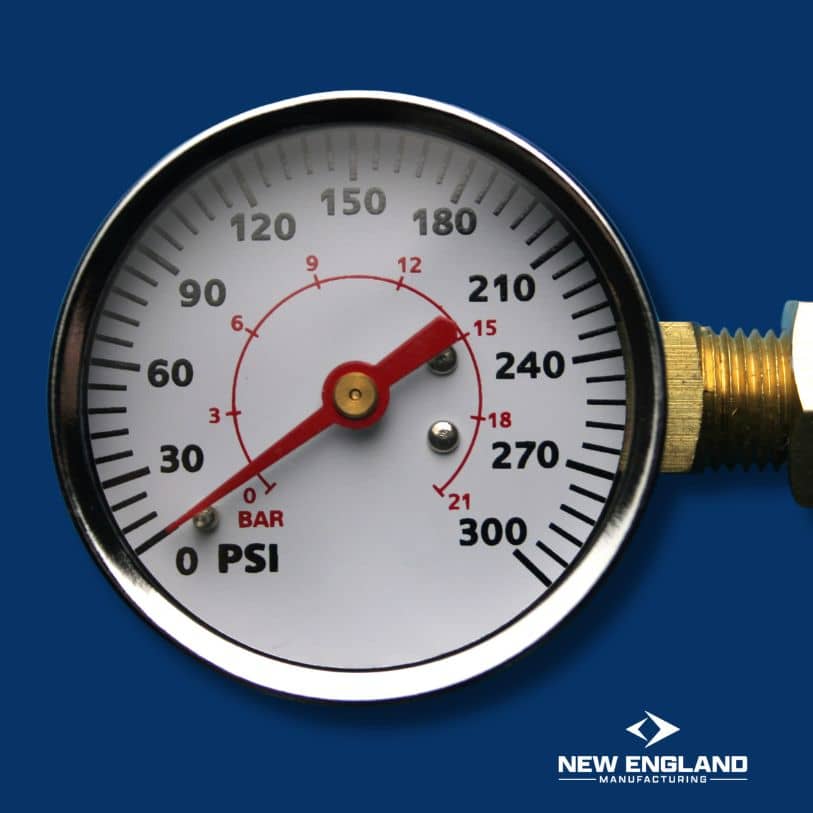Pressure Measurement Fundamentals: Relative Pressure vs Absolute Pressure
Fire protection systems depend heavily on accurate pressure calculations.
Personnel from fire protection companies, insurance underwriters, system installers, and fire departments must distinguish between relative pressure vs absolute pressure to ensure system reliability during emergencies.
Relative Pressure vs Absolute Pressure: Essential Distinctions
The distinction between relative pressure vs absolute pressure hinges on the reference points used during measurement. These differences affect system design, component selection, and operational parameters throughout the fire protection infrastructure.
What is Absolute Pressure?
Absolute pressure measures total pressure against a perfect vacuum (zero pressure). This measurement includes atmospheric pressure plus any additional system pressure.
Equipment operating under variable atmospheric conditions benefits particularly from absolute pressure monitoring.
An absolute pressure sensor contains a sealed vacuum chamber reference.
These devices deliver measurements independent of ambient atmospheric fluctuations, proving valuable for high-altitude installations, vacuum systems, and applications requiring consistent readings regardless of environmental changes.
Mathematically expressed, absolute pressure equals the total of all pressure forces acting upon a surface, measured from a perfect vacuum reference.
Relative Pressure Mechanics
Relative pressure measurements compare system pressure against local atmospheric pressure. Also called gauge pressure, this measurement appears most commonly on standard pressure gauges throughout fire protection systems.
When documentation mentions “pressure” without specifying the type, gauge pressure typically represents the intended measurement.
The relationship follows this equation:
Absolute Pressure = Relative Pressure + Atmospheric Pressure
At sea level, under standard conditions, atmospheric pressure approximates 14.7 psi (101.325 kPa), though it varies with altitude and weather patterns.
Gauge pressure can register positive values (above atmospheric pressure) or negative values (below atmospheric pressure, sometimes termed vacuum pressure).
Fire suppression systems typically operate at positive gauge pressures to ensure effective agent delivery during discharge events.
Technical Pressure Foundations
Pressure represents force applied per unit area, measured commonly in pascals (Pa), pounds per square inch (psi), or bars. Different measurement systems exist across industries, but all fire protection equipment requires precise pressure control.
Water-based suppression systems, gas-based extinguishing mechanisms, and detection networks utilize pressure parameters in their design and operation.
Fire Protection System Applications
Understanding gauge pressure vs absolute pressure affects numerous aspects of fire protection infrastructure:
Pump Systems
Fire pumps deliver water at specified pressures regardless of environmental conditions. NFPA 20 establishes requirements for pump installations, specifying minimum pressures for various applications.
These specifications typically reference gauge pressure, though underlying absolute pressure principles remain critical for consistent system performance.
Consider these application scenarios:
- Standard commercial building requiring 175 psi pump discharge pressure
- High-rise structures need pressure-regulating devices to manage excessive pressures at lower floors
- Industrial facility at high elevation requiring compensatory pressure calculations
Each scenario demands accurate pressure measurements appropriate to the application environment.
Sprinkler Network Engineering
Automatic sprinkler systems rely on hydraulic calculations for required pressures throughout piping networks. NFPA 13 establishes minimum pressure requirements for various sprinkler types, typically as gauge pressure values.
Critical sprinkler pressure considerations include:
- Minimum operating pressures by sprinkler type (standard spray, ESFR, CMSA)
- Maximum pressure limitations for specific components
- Pressure loss calculations through pipe networks
- Elevation effects on pressure throughout multi-level systems
Hydraulic calculations utilize gauge pressure values, though absolute pressure concepts become relevant when addressing altitude effects or atmospheric pressure variations.
Standpipe Installations
Standpipe systems provide water connections for manual firefighting operations. NFPA 14 establishes minimum pressure requirements at standpipe outlets, specifying residual pressure values measured as gauge pressure.
Class I standpipes require a minimum residual pressure of 100 psi at the hydraulically most remote 2½-inch outlet. Class II standpipes require a minimum residual pressure of 65 psi at the hydraulically most remote 1½-inch hose connection.
These requirements ensure adequate pressure for manual firefighting operations throughout protected structures.
Testing Methodology
Fire protection systems undergo commissioning tests and periodic inspections, which verify compliance with applicable standards. These procedures frequently involve pressure measurements requiring proper interpretation.
Common testing scenarios include:
- Hydrostatic testing of newly installed piping
- Main drain tests measuring water supply pressure under flow conditions
- Fire pump testing, verifying performance against design curves
- Standpipe flow tests confirming adequate pressure at remote outlets
Each test requires appropriate pressure measurement methodology, correct interpretation of results, and a clear understanding of whether absolute pressure vs relative pressure applies to specific test parameters.
Relative vs Absolute Barometric Pressure
Barometric pressure measurements affect fire protection systems, particularly installations spanning multiple elevations or facilities subject to significant weather-related barometric fluctuations.
Absolute barometric pressure represents atmospheric pressure measured against a vacuum reference. Relative barometric pressure undergoes adjustment to sea level equivalent for standardization purposes, primarily in meteorological reporting.
These distinctions matter for:
- High-rise building systems are experiencing pressure changes with elevation
- Facilities in regions experiencing extreme weather patterns influencing barometric pressure
- Systems installed at high altitudes require compensatory calculations
- Dry pipe or pre-action systems, where air pressure balances against water supply pressure
Technical Implementation Considerations
Fire protection professionals should address these practical considerations when dealing with pressure measurements:
Measurement Equipment Selection
Pressure measurement devices include:
- Bourdon tube gauges (most common for local indication)
- Digital pressure transducers (for remote monitoring)
- Differential pressure sensors (for flow measurement)
- Compound gauges (measuring both positive and negative pressures)
Equipment selection should match application requirements, calibration frequency, and environmental conditions. Installation should follow manufacturer guidelines regarding orientation, vibration isolation, and pressure snubbing where required.
Documentation Protocols
System documentation must specify pressure measurement types.
Design documents, test reports, inspection records, and maintenance documentation should explicitly indicate whether values reference absolute vs relative pressure to prevent misinterpretation during system modifications or emergency response.
Environmental Factors
Multiple environmental factors influence pressure measurements:
- Altitude effects: Atmospheric pressure decreases approximately 1 inHg per 1,000 feet of elevation gain
- Temperature variations: Pressure varies with temperature, following gas laws
- Weather systems: High and low-pressure weather patterns affect baseline atmospheric pressure
- Building stack effect: Air pressure differences between the building interior and exterior due to temperature differential and building height
These factors require consideration during system design, installation, testing, and maintenance to ensure reliable operation under all conditions.
Monitoring Technology Integration
Modern fire protection systems increasingly incorporate advanced monitoring technologies:
- Digital pressure monitoring with continuous data logging
- Remote supervision capabilities with alarm notification
- Building management system integration, enabling comprehensive oversight
- Predictive maintenance algorithms identifying pressure anomalies before failure
These technologies enhance system reliability while reducing maintenance costs through early problem detection.
Pressure Measurement Conversion Methodology
Converting between pressure measurement types requires understanding the following relationships:
To determine absolute pressure from gauge pressure: Pabsolute = Pgauge + Patmospheric
To calculate gauge pressure from absolute pressure: Pgauge = Pabsolute – Patmospheric
Atmospheric pressure varies with:
- Altitude (approximately 0.5 psi decrease per 1,000 feet elevation gain)
- Weather conditions
- Local environmental factors (temperature, humidity)
Conversion Example Analysis
Consider a fire pump system operating at 100 psi gauge pressure at sea level: Absolute pressure = 100 psi + 14.7 psi = 114.7 psi
The same system at 5,000 feet elevation (atmospheric pressure ≈ 12.2 psi): Absolute pressure = 100 psi + 12.2 psi = 112.2 psi
This 2.5 psi difference demonstrates why pressure specifications must indicate reference points, particularly for systems operating across varying elevations or environmental conditions.
Industry Standards Framework
Multiple regulatory bodies and industry standards address pressure requirements in fire protection systems:
- NFPA 13: Standard for the Installation of Sprinkler Systems
- NFPA 14: Standard for the Installation of Standpipe and Hose Systems
- NFPA 20: Standard for the Installation of Stationary Pumps for Fire Protection
- NFPA 25: Standard for the Inspection, Testing, and Maintenance of Water-Based Fire Protection Systems
- Factory Mutual (FM) Global Property Loss Prevention Data Sheets
- Local building codes and jurisdictional requirements
These standards typically express pressure requirements as gauge pressure values, though understanding underlying absolute pressure principles remains essential for proper implementation across various environmental conditions.
Specialized System Applications
Understanding relative vs absolute pressure enables effective implementation of specialized fire protection systems:
Foam Proportioning Systems
Foam-water suppression systems utilize proportioning devices operating on pressure differential principles.
Balanced pressure proportioners, pressure proportioning tanks, and water-powered concentrate pumps all depend on precise pressure relationships for proper operation.
These systems typically utilize gauge pressure measurements, though altitude corrections may apply for installations at significant elevations.
Water Mist Technologies
High-pressure water mist systems operate at pressures exceeding 500 psi. At these elevated pressures, the distinction between absolute vs gauge pressure becomes increasingly significant, particularly in high-rise buildings or varying elevations.
Water mist nozzle discharge characteristics depend on precise pressure control, with variations potentially affecting droplet size distribution and fire suppression effectiveness.
Clean Agent Systems
Clean agent suppression systems utilizing halocarbon agents or inert gases depend on pressure measurements for proper agent storage, release, and concentration maintenance.
These systems frequently incorporate pressure switches monitoring agent cylinder pressure, with detection typically based on gauge pressure measurements.
Ambient temperature variations affect cylinder pressure readings, requiring temperature compensation for accurate monitoring. Understanding absolute pressure principles helps interpret these variations correctly.
Vacuum Detection Networks
Specialized detection systems utilize vacuum conditions for smoke or fire detection. These systems maintain negative gauge pressure while monitoring for pressure changes indicating system breach or fire conditions.
Understanding absolute pressure becomes critical, as vacuum pressure represents negative gauge pressure but always positive absolute pressure. Proper monitoring requires sensors calibrated appropriately for the application.
Practical Implementation Guidelines
When implementing fire protection systems requiring pressure monitoring:
- Specify pressure gauges appropriate for the application environment
- Install gauges following manufacturer’s recommendations regarding orientation and isolation
- Establish regular calibration protocols, ensuring measurement accuracy
- Document all pressure requirements, indicating measurement reference (gauge vs absolute)
- Consider environmental factors affecting pressure readings when designing systems
- Implement appropriate monitoring technology based on system criticality
- Train personnel regarding proper pressure measurement interpretation
These practices enhance system reliability while ensuring regulatory compliance.
Technological Advancements
Recent technological developments affecting pressure measurement in fire protection systems include:
- Wireless pressure monitoring, enabling remote supervision without extensive wiring
- Self-calibrating pressure sensors, reducing maintenance requirements
- Internet-connected monitoring systems provide real-time oversight and data analysis
- An advanced diagnostics detecting system deterioration before failure
- Integrated testing capabilities streamlining inspection procedures
These technologies improve system reliability while reducing lifecycle costs through enhanced monitoring and predictive maintenance capabilities.
A thorough understanding of relative pressure vs absolute pressure concepts forms an essential component of fire protection engineering knowledge.
This comprehension ensures appropriate system design, accurate installation, proper testing, and effective maintenance protocols.
By correctly applying pressure measurement principles, fire protection companies, insurance underwriters, system installers, and fire departments develop and maintain systems that perform reliably during emergency conditions, ultimately enhancing life safety and property protection throughout protected facilities.
Continued education regarding pressure measurement fundamentals contributes significantly to the advancement of fire protection technology and implementation methodologies across diverse built environments.

Mark R.
With a strong foundation in industrial safety and fire protection systems, Mark R. specializes in creating clear, technical, and compliance-driven content. Writing for SafeTech Reports, he covers topics such as fire hydrant testing, PPE protocols, emergency procedures, and smart technology integration in safety systems. His work ensures that professionals stay informed on the latest regulations, best practices, and emerging trends in safety and infrastructure maintenance.
Get in touch
We usually respond within 24 hours
Need Reliable Water Flow Test Equipment?
For over 70 years, New England Manufacturing has been the trusted source for fire hydrant and water flow testing kits. From pitot gauge kits to custom test kits, we provide precision, durability, and expert calibration to meet your needs.
- Custom-built test kits
- High-quality pressure gauges
- Reliable calibration services




